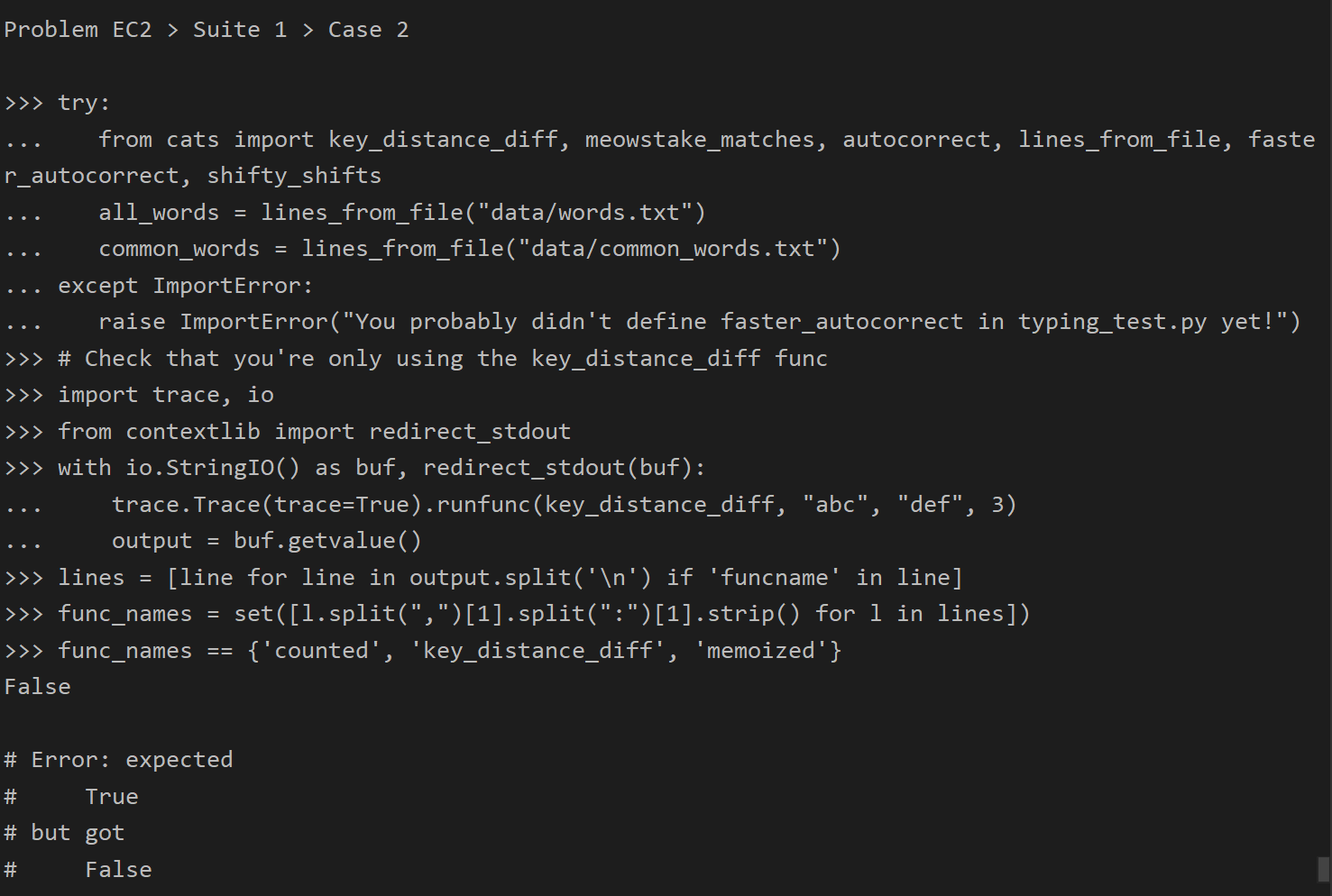UCB CS61A笔记

因为做到Hog的Problem7才发觉应该要做笔记,所以之前的就没有了,从那个题开始,GitHub仓库地址
关于Debug
可以通过下面的语句来Debug而不引发OK系统的错判
print("DEBUG:", x)
Homework 2: Higher-Order Functions
关于Church数
https://www.cnblogs.com/ZHDreamer/p/15929157.html
Hog
这是要写一个赌博游戏
终于在5月9号凌晨写完了
Problem 7
没啥好说的,就是我最后返回 last_score+score还查错了好久就显得很蠢
Problem 8/9/10/11
很快地写完了,没啥好说的
Lab 5
Q4: Sprout leaves
if is_leaf(t):
return tree(label(t), [tree(x) for x in leaves])
return tree(label(t), [sprout_leaves(x, leaves) for x in branches(t)])
注意这里要用他给出 tree函数来进行合成,而不是自己在前后加括号搞个数组(一开始我就这么做,很难调试,最主要的是违反了抽象原则)
When writing functions that use an ADT, we should use the constructor(s) and selector(s) whenever possible instead of assuming the ADT's implementation. Relying on a data abstraction's underlying implementation is known as violating the abstraction barrier, and we never want to do this!
Q6: Add trees
Hint : You may want to use the built-in zip function to iterate over multiple sequences at once.
用法如下
>>> a = [1,2,3]
>>> b = [4,5,6]
>>> c = [4,5,6,7,8]
>>> zipped = zip(a,b) # 返回一个对象
>>> zipped
<zip object at 0x103abc288>
>>> list(zipped) # list() 转换为列表
[(1, 4), (2, 5), (3, 6)]
>>> list(zip(a,c)) # 元素个数与最短的列表一致
[(1, 4), (2, 5), (3, 6)]
>>> a1, a2 = zip(*zip(a,b)) # 与 zip 相反,zip(*) 可理解为解压,返回二维矩阵式
>>> list(a1)
[1, 2, 3]
>>> list(a2)
[4, 5, 6]
>>>
解答如下,稍微有点复杂
if is_leaf(t1):
return tree(label(t1) + label(t2), branches(t2))
if is_leaf(t2):
return tree(label(t1) + label(t2), branches(t1))
if len(branches(t1)) < len(branches(t2)):
t1, t2 = t2, t1
t2_new = tree(label(t2), branches(t2) + [tree(0) for i in range(len(branches(t1)) - len(branches(t2)))])
zip_tree = zip(branches(t1), branches(t2_new))
return tree(label(t1) + label(t2), [add_trees(x, y) for x, y in zip_tree])
Putting it all together
注意要用命令 winpty python -i lab05.py
Homework 4: Data Abstraction, Trees
Q5: Preorder
如果用到这个 sum函数就会很方便,可以用来合并数组
lst = [[1, 2], [3, 4]]
print(sum(lst, []))
#[1, 2, 3, 4]
Q6: Has Path
用any会很方便
any() 函数用于判断给定的可迭代参数 iterable 是否全部为 False,则返回 False,如果有一个为 True,则返回 True。
元素除了是 0、空、False 外都算 True。
>>> any(['a', 'b', 'c', 'd']) # 列表list,元素都不为空或0
True
>>> any(['a', 'b', '', 'd']) # 列表list,存在一个为空的元素
True
>>> any([0, '', False]) # 列表list,元素全为0,'',false
False
>>> any(('a', 'b', 'c', 'd')) # 元组tuple,元素都不为空或0
True
>>> any(('a', 'b', '', 'd')) # 元组tuple,存在一个为空的元素
True
>>> any((0, '', False)) # 元组tuple,元素全为0,'',false
False
>>> any([]) # 空列表
False
>>> any(()) # 空元组
False
Q9: Div Interva
注意当 assert错误时在OK系统中要输出 AssertionError,今天因为这个sb错误调了二十分钟
Lab 6: Nonlocal, Mutability
注意 nonlocal关键字的使用,可以修改父帧的变量
def make_withdraw(balance):
"""Returns a function which can withdraw
some amount from balance
>>> withdraw = make_withdraw(50)
>>> withdraw(25)
25
>>> withdraw(25)
0
"""
def withdraw(amount):
nonlocal balance
if amount > balance:
return "Insufficient funds"
balance = balance - amount
return balance
return withdraw
Q3: List-Mutation
注意Python里面的 remove函数是删除这个值而不是这个位置
Homework 5: Nonlocal, Iterators & Generators
Q4: Merge
注意 yield的用法,下面是一些粗浅的理解:
当一个函数 foo里面有 yield而不是 return的时候,调用 foo()会返回一个迭代器(所以也就不会执行里面的语句),其他的直接参考下面的代码即可理解
def foo():
print("starting...")
while True:
res = yield 4
print("res:",res)
g = foo()
#没有输出
print(next(g))
#输出: starting...
#输出: 4
print("*"*20)
#输出: ********************
print(next(g))
#输出: res: None
#输出: 4
Q6: Remainder Generator
这个题要用高阶生成器做,有点难度,看了网站上的视频感觉没任何有用信息,之后又在AI的提示下做出来的(AI一开始也不对,乐)
def remainders_generator(m):
"""
Yields m generators. The ith yielded generator yields natural numbers whose
remainder is i when divided by m.
>>> import types
>>> [isinstance(gen, types.GeneratorType) for gen in remainders_generator(5)]
[True, True, True, True, True]
>>> remainders_four = remainders_generator(4)
>>> for i in range(4):
... print("First 3 natural numbers with remainder {0} when divided by 4:".format(i))
... gen = next(remainders_four)
... for _ in range(3):
... print(next(gen))
First 3 natural numbers with remainder 0 when divided by 4:
4
8
12
First 3 natural numbers with remainder 1 when divided by 4:
1
5
9
First 3 natural numbers with remainder 2 when divided by 4:
2
6
10
First 3 natural numbers with remainder 3 when divided by 4:
3
7
11
"""
"*** YOUR CODE HERE ***"
def gen(x):
while True:
yield x
x += m
for i in range(m):
if i == 0:
yield gen(m)
else:
yield gen(i)
Lab 8: Object-Oriented Programming
There are also some built-in functions that take in iterables and return useful results:
map(f, iterable)- Creates iterator overf(x)for eachxiniterablefilter(f, iterable)- Creates iterator overxfor eachxiniterableiff(x)zip(iter1, iter2)- Creates iterator over co-indexed pairs (x, y) from both input iterablesreversed(iterable)- Creates iterator over all the elements in the input iterable in reverse orderlist(iterable)- Creates a list containing all the elements in the input iterabletuple(iterable)- Creates a tuple containing all the elements in the input iterablesorted(iterable)- Creates a sorted list containing all the elements in the input iterable
Q1: WWPD
注意以下语法,其实我们在Python中遍历数组的时候也是在用迭代器
>>> r = range(6)
>>> r_iter = iter(r)
>>> next(r_iter)
0
>>> [x + 1 for x in r]
[1, 2, 3, 4, 5, 6]
>>> [x + 1 for x in r_iter]
[2, 3, 4, 5, 6]
Q2: Generators generator
这个题有点难,一开始没搞明白,看了答案才懂
主要的难点在于想到用 for entry in g():
这种题用辅助函数也是容易想到的(但是我没想到,乐)
def make_generators_generator(g):
"""Generates all the "sub"-generators of the generator returned by
the generator function g.
>>> def every_m_ints_to(n, m):
... i = 0
... while (i <= n):
... yield i
... i += m
...
>>> def every_3_ints_to_10():
... for item in every_m_ints_to(10, 3):
... yield item
...
>>> for gen in make_generators_generator(every_3_ints_to_10):
... print("Next Generator:")
... for item in gen:
... print(item)
...
Next Generator:
0
Next Generator:
0
3
Next Generator:
0
3
6
Next Generator:
0
3
6
9
"""
"*** YOUR CODE HERE ***"
def gen_helper(num):
gen = g()
for i in range(num):
yield next(gen)
i = 1
for entry in g():
yield gen_helper(i)
i += 1
Homework 6: Object-Oriented Programming, Linked Lists, Trees
Q8: Deep Map
Hint: You may find the built-in isinstance function useful. You can also use the type(link) == Link to check whether an object is a linked list (like you did in homework 3 question 1).
注意这个辅助函数的用法,可以用来判断是否为 Link类型
def helper(link):
if link is Link.empty:
return Link.empty
elif type(link.first) == Link:
return Link(helper(link.first), helper(link.rest))
else:
return Link(f(link.first), helper(link.rest))
Project 2: Cats
Extra Credit Problem 2: Efficiency

ChatGPT告诉我们
这段代码是一个测试代码片段,用于验证在
typing_test.py中是否正确定义了特定的函数和函数名称。首先,代码尝试导入一些函数:
key_distance_diff、meowstake_matches、autocorrect、lines_from_file、faster_autocorrect和shifty_shifts。然后,它从文件中加载单词列表,并检查导入是否成功。如果导入失败,则会引发ImportError并给出相应的错误信息。接下来,代码使用
trace模块和io.StringIO上下文管理器来捕获函数的调用信息。它运行了key_distance_diff函数,并将输出重定向到buf。然后,它从输出中提取出调用函数的相关行信息,并提取出函数名称。最后,它将提取的函数名称与预期的函数名称集合进行比较,即{'counted', 'key_distance_diff', 'memoized'}。如果比较结果为
True,则意味着key_distance_diff函数是在代码中唯一被使用的函数。否则,可能意味着其他函数也被调用了,需要进行检查。这段代码主要用于代码质量控制和测试,以确保程序正确地调用了特定的函数并遵守预期行为。
一开始我用的迭代式的DP而不是递归式做的,结果就寄了(原因不确定)
注意这个 memo函数的实现,这里 memo是每次只要进入函数就会有 count所以要过关要求的是不能进入
key_distance_diff函数
def memo(f):
"""A memoization function as seen in John Denero's lecture on Growth"""
cache = {}
def memoized(*args):
if args not in cache:
cache[args] = f(*args)
return cache[args]
return memoized
那么只有当 f采用递归实现的时候 memo才有意义,所以 key_distance_diff应该修改一下
def key_distance_diff(start, goal, limit):
""" A diff function that takes into account the distances between keys when
computing the difference score."""
start = start.lower() # converts the string to lowercase
goal = goal.lower() # converts the string to lowercase
# BEGIN PROBLEM EC1
"*** YOUR CODE HERE ***"
# dp = [[0 for j in range(len(goal) + 1)] for i in range(len(start) + 1)]
# for i in range(len(start) + 1):
# for j in range(len(goal) + 1):
# if i == 0:
# dp[i][j] = j
# elif j == 0:
# dp[i][j] = i
# elif start[i - 1] == goal[j - 1]:
# dp[i][j] = dp[i - 1][j - 1]
# else:
# dp[i][j] = min(1 + dp[i][j - 1], 1 + dp[i - 1][j],
# key_distance[start[i - 1], goal[j - 1]] + dp[i - 1][j - 1])
# if dp[len(start)][len(goal)] > limit:
# return float('inf')
# return dp[len(start)][len(goal)]
if limit < 0:
return float('inf')
if len(start) == 0 or len(goal) == 0:
# BEGIN
"*** YOUR CODE HERE ***"
return len(start) + len(goal)
# END
elif start[0] == goal[0]:
return key_distance_diff(start[1:], goal[1:], limit)
else:
add_diff = 1 + key_distance_diff(start, goal[1:], limit - 1)
remove_diff = 1 + key_distance_diff(start[1:], goal, limit - 1)
kd = key_distance[(start[0], goal[0])]
substitute_diff = kd + key_distance_diff(start[1:], goal[1:], limit - 1)
# BEGIN
"*** YOUR CODE HERE ***"
return min(min(add_diff, remove_diff), substitute_diff)
# END PROBLEM EC1
另外注意这里的写法(Python是真的方便)
words_diff = [diff_function(user_word, w, limit) for w in valid_words]
similar_word, similar_diff = min(zip(valid_words, words_diff), key=lambda item: item[1])
调了很久破案了,原来是因为这个,什么OI常用技巧,这也要记忆化是吧,乐
min_diff = limit + 1
for valid_word in valid_words:
if diff_function(user_word, valid_word, limit) < min_diff:
min_diff = diff_function(user_word, valid_word, limit)
min_word = valid_word
正确代码如下
min_diff = limit + 1
for valid_word in valid_words:
diff = diff_function(user_word, valid_word, limit)
if diff < min_diff:
min_diff = diff
min_word = valid_word
Project 3: Ants
注意Python中类的实例属性和类属性的区别
class Dogs(object):
# 类属性
belongTo = "Animals"
def __init__(self, name):
#实例属性
self.name = name
Problem 5
注意如何调用父类的函数(两种方法分别是 super().xxx和 Ant.xxx)
Problem 9
Hint: You may find the
isinstancefunction useful for checking if an object is an instance of a given class. For example:
>>> a = Foo()
>>> isinstance(a, Foo)
True
Note: the constructor of
ContainerAnt.__init__is implemented as such这个用法很重要
def __init__(self, *args, **kwargs):
Ant.__init__(self, *args, **kwargs)
self.contained_ant = None
As we saw in Hog, we have that
argsis bound to all positional arguments (that is all arguments not passed not with keywords, andkwargsis bound to all the keyword arguments. This ensures that both sets of arguments are passed to the Ant constructor).Effectively, this means the constructor is exactly the same as
Ant.__init__but setsself.contained_ant = None
如下
def print_func(x, *args, **kwargs):
print(x)
print(args)
print(kwargs)
print_func(1, 2, 3, 4, y=1, a=2, b=3, c=4)
#输出结果
1
(2, 3, 4)
{'y': 1, 'a': 2, 'b': 3, 'c': 4}
Problem 13
这个挺麻烦的,改了不少地方,而且也不好参考别人的,一个细节是要考虑 ContainerAnt自己也可以造成伤害,所以在改 action的时候要考虑这个
Python pass 是空语句,是为了保持程序结构的完整性。
pass 不做任何事情,一般用做占位语句。
一个教训,能用父类的方法就直接用,增而不是改,下面是前后对比(前者错了并且一直调不出来)
def reduce_armor(self, amount):
"""Reduce armor by AMOUNT, and if the True QueenAnt has no armor
remaining, signal the end of the game.
"""
# BEGIN Problem 13
"*** YOUR CODE HERE ***"
self.armor -= amount
if self.armor <= 0:
if self.index == 1:
bees_win()
print("DEBUG: ", self, self.index, self.place)
self.place.remove_insect(self)
self.death_callback()
# END Problem 13
def remove_from(self, place):
# BEGIN Problem 13
"*** YOUR CODE HERE ***"
if place.ant is None:
assert False, '{0} is not in {1}'.format(self, place)
elif place.ant is self:
if self.index == 1:
return
QueenAnt.count -= 1
place.ant = None
Ant.remove_from(self, place)
# END Problem 13
def reduce_armor(self, amount):
"""Reduce armor by AMOUNT, and if the True QueenAnt has no armor
remaining, signal the end of the game.
"""
# BEGIN Problem 13
"*** YOUR CODE HERE ***"
Ant.reduce_armor(self, amount)
if self.armor <= 0 and self.index == 1:
bees_win()
# END Problem 13
def remove_from(self, place):
# BEGIN Problem 13
"*** YOUR CODE HERE ***"
if self.index == 1:
pass
else:
super().remove_from(place)
# END Problem 13
Lab 10: Scheme, Scheme Lists
Q1: WWSD: Lists
基本就是中缀表达式,注意有关 list的操作
scm> (define a (cons 1 (cons 2 (cons 3 nil)))) ; Assign the list to the name a
a
scm> a
(1 2 3)
scm> (car a)
1
scm> (cdr a)
(2 3)
scm> (car (cdr (cdr a)))
3
scm> (list 1 2 3)
(1 2 3)
scm> (list 1 (list 2 3) 4)
(1 (2 3) 4)
scm> (list (cons 1 (cons 2 nil)) 3 4)
((1 2) 3 4)
下面是几个有点tricky的题目(注意引用和非引用的区别)
scm> (cons 1 '(list 2 3))
(1 list 2 3)
scm> (cons 1 (list (cons 3 nil) 4 5))
(1 (3) 4 5)
Q3: Filter Lst
Write a procedure
filter-lst, which takes a predicatefnand a listlst, and returns a new list containing only elements of the list that satisfy the predicate. The output should contain the elements in the same order that they appeared in the original list.
这里考的是递归(在Scheme中,基本不会使用循环迭代,因为递归更符合函数式编程的思想,而且循环迭代都能用递归实现)
(define (filter-lst fn lst)
'YOUR-CODE-HERE
(cond ((null? lst) '())
((fn (car lst)) (cons (car lst) (filter-lst fn (cdr lst))))
(else (filter-lst fn (cdr lst))))
)
Q9: Substitute
Hint : The built-in
pair?predicate returns True if its argument is aconspair.
搞了缩进之后明显好看并且好调多了
(define (substitute s old new)
'YOUR-CODE-HERE
(if (null? s)
'()
(if (pair? (car s))
(cons (substitute (car s) old new) (substitute (cdr s) old new))
(if (equal? (car s) old) (cons new (substitute (cdr s) old new))
(cons (car s) (substitute (cdr s) old new))
)
)
)
)
Lab 11: Interpreters
Q4: Applying Lambda Functions
注意下面这个例子,很 tricky
>>> read('(lambda x: x(x))(lambda y: 4)').eval(global_env)
Number(4)

 这不仅仅是一门编程语言课,而是会深入到程序构造与运行的原理。最后你将在第 4 个 Project 中用 Python 实现一个 Scheme 的解释器。此外,抽象将是这门课的一大主题,你将学习到函数式编程、数据抽象、面向对象等等知识来让你的代码更易读,更模块化。当然,学习编程语言也是这门课的一大内容,你将会掌握 Python、Scheme 和 SQL 这三种编程语言,在它们的学习和比较中,相信你会拥有快速掌握一门新的编程语言的能力。
这不仅仅是一门编程语言课,而是会深入到程序构造与运行的原理。最后你将在第 4 个 Project 中用 Python 实现一个 Scheme 的解释器。此外,抽象将是这门课的一大主题,你将学习到函数式编程、数据抽象、面向对象等等知识来让你的代码更易读,更模块化。当然,学习编程语言也是这门课的一大内容,你将会掌握 Python、Scheme 和 SQL 这三种编程语言,在它们的学习和比较中,相信你会拥有快速掌握一门新的编程语言的能力。


【推荐】国内首个AI IDE,深度理解中文开发场景,立即下载体验Trae
【推荐】编程新体验,更懂你的AI,立即体验豆包MarsCode编程助手
【推荐】抖音旗下AI助手豆包,你的智能百科全书,全免费不限次数
【推荐】轻量又高性能的 SSH 工具 IShell:AI 加持,快人一步
· 分享一个免费、快速、无限量使用的满血 DeepSeek R1 模型,支持深度思考和联网搜索!
· 使用C#创建一个MCP客户端
· ollama系列1:轻松3步本地部署deepseek,普通电脑可用
· 基于 Docker 搭建 FRP 内网穿透开源项目(很简单哒)
· 按钮权限的设计及实现